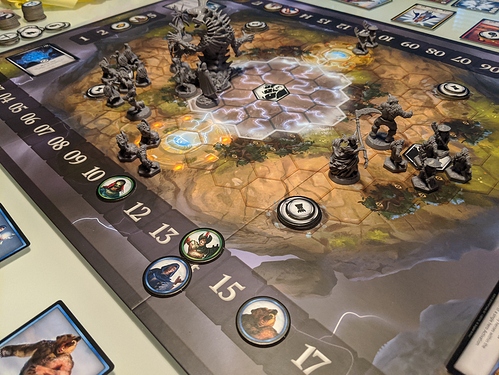Thought I should probably post here, as I’ve played both? Though I have limited experience at this point (thanks to lockdown), so take my thoughts with a grain of salt.
As @VictorViper said above, I think Godtear is easily the more accessible of the two.
Skytear possibly has more “up front” info to learn than even Aristeia, which has a fair amount. There is a simplified side for the heroes, which is currently all we’ve played, but you lose a lot. There is an entire action you lose (something akin to prayer/focus that is unique for each “class”), and it seems to really impact the game.
I don’t plan to dive into the deck construction of Skytear, but it is an option, and I’ve heard it’s fairly deep if you want get into it. If not, there are pre-con decks for each hero online, and you can draft and “shuffle build” your deck.
Also, there is a very active Discord for Skytear, and the designers are often there to answer questions Asia the community (which seems to be great so far).
While Godtear doesn’t have the deck construction, how you draft your team still has a strong impact. The dual phase (Plot/Clash) is really interesting, and opens up some really interesting decisions. In some ways, Godtear is a mix of big old school skirmish games (like 40k) and smaller more modern skirmish games.
The Plot phase is very similar to 40k as it’s an “I go, you go” system. Champions are placed in an alternating fashion, but than the “first player” moves all of their units, and performs any Plot phase actions (no attacks generally, but there are units that break this rule).
After the Plot phase is the Clash phase, which is an alternating activation system, and where the majority of the combat will happen. This phase is very reminiscent of Warhammer Underworlds, minus the card play. The variable scoring of Godtear is interesting as well. The rounds escalate to Round 3, than calm back down. Leads to a fairly unique flow, and (so far) can help alleviate the idea that you’re not really in it.
To break down;
Rounds 1 & 5 = 1 point
Rounds 2 & 4 = 2 points
Round 3 = 3 points.
Sure, you can lose 3 straight, but even if you lose 1 and 2, you know you you’re still in it (usually).
Skytear is more of a direct MOBA inspired game, and you can win by destroying an enemy Nexus (home base basically), or on the standard 2-lane map, by achieving one of 3 randomly drawn goals; note that one downside is there are no tokens to track the ones that need to be tracked, so you’ll need to get creative, lol).
The larger 3-lane map can only be won by destroying the enemy Nexus, but we’ve not tried this yet. I hope to soon. There is also a smaller 1-lane map coming soon, that promises quicker games (20-40 minutes), which will be nice. This can be a big plus, as Godtear feels like it would loose too much if you cut the size down, and had fewer Champions (though maybe an alternative map would help?).
So after all that rambling, where do I stand?? No idea, lol. I really do enjoy both. While they have many differences, there are some similarities;
Drafting your team
Positioning is very important in both
Unique feel from other skirmish games (though Skytear possibly takes the edge here as it feels more akin to a true MOBA from my understanding).
All of that said, never forget that I also have a problem and have more skirmish games than any other single genre, so grain of salt and all that.
If I were to recommend one over the other, it would depend on a few factors; Skytear has a lower buy-in, and the starter box is actually a full game. Godtear requires 2 starter boxes, plus 2 Champion packs, or 1 Starter and 4 Champion packs for a full 2 player game. That would still only be 6 Champions, which would not be a ton of variety, especially as there is no deck construction to add to said variety. Makes it hard for me to really recommend.
However, Godtear is (imo) significantly more accessible, once you grok the Plot/Clash phases.
Given that you already have Aristeia, I would possibly lean towards Skytear. All three games have area-control elements, but Skytear has the option of the smaller map and shorter game, which may or may not be a factor, plus variable win-cons on the “standard” map.
On the positive side, both games seem to be getting a fair amount of support. Both have all of the KS content at, or soon coming to, retail. Both also have more announced content, though I believe Godtear is further down the line; I don’t think they have a released planned until August.
TL:DR - I would probably recommend Skytear, even though I suspect Godtear may end up being my preferred of the 2.
As an aside, I asked my son what he thought, and he said Skytear for similar reasons. He prefers Godtear (in part because it’s easier for him to understand), but given what you need just to have a full game, he wouldn’t recommend it on general principle.
Hope that long ass posts has some useful info in it! 


